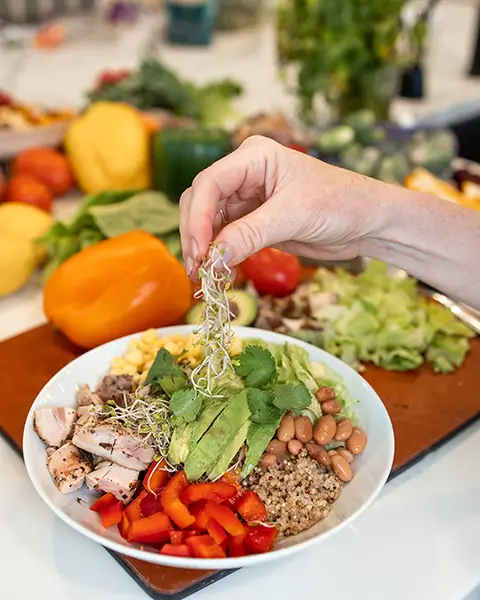What is Fibermaxxing? Fibermaxxing is the latest nutrition trend making the rounds on TikTok and Instagram. It’s the idea that if you just keep piling on more fiber, you’ll reap double the benefits. For some people that means smoother digestion, steadier blood sugar, and less bloating by the end of the day. But for others, jumping from 10 grams of fiber to 40 grams overnight leaves them with gas, stomach pressure, and unpredictable bathroom habits.
The truth is, fiber isn’t optional. Your microbiome depends on it. But how you add it, what type you choose, and the pace you increase it at all make a difference. Whenever you are incorporating more fiber into your diet it is beneficial to know how your body (and gut) will respond so you can get the benefits and prevent the side effects.
Why Fibermaxxing is Trending
Protein had its moment with protein popcorn and protein ice cream. Now, fiber is in the spotlight as the new “nutrition it girl”. And it makes sense because most Americans eat less than half the recommended daily fiber. Women need about 25 grams per day, men 35–38 grams, but most people are only hitting 10–15. Instead of focusing on restriction, this trend is about adding more plants, herbs, spices, beans, grains, nuts, and seeds to your plate.
The catch? More isn’t always better. If fiber keeps backfiring, you need to address your gut (and why you cannot tolerate fiber).
The Different Types of Fiber
Not all fiber acts the same way in the body. Here’s a breakdown you can reference (and you can easily add product links in the far-right column when you’re ready):
| Fiber Type | Who It’s For | How to Add It | Example Products/Foods |
|---|---|---|---|
| Soluble Fiber (oats, beans, chia, apples) | Helpful for constipation and diarrhea; softens stool and steadies blood sugar | Add chia seeds to smoothies, swap rice for lentils, enjoy apples with nut butter | Partially hydrolyzed guar gum (Sunfiber), acacia fiber |
| Insoluble Fiber (greens, nuts, seeds, bran) | Adds bulk and speeds things up, best once motility is steady | Cooked veggies, handful of nuts, ground flax on yogurt | Wheat bran, flax products |
| Prebiotic Fiber (onion, garlic, asparagus, inulin) | Specifically feeds good bacteria like bifidobacteria, but may cause gas for sensitive guts | Small amounts of cooked onion/garlic, try prebiotic powder | PHGG (Sunfiber or Regular girl), acacia gum, Fiome (these contain Inulin and can be harder to tolerate) |
| Resistant Starch (green banana flour, cooled potatoes, legumes) | Great for constipation, methane producers, or sensitive guts | Cook, cool, and reheat potatoes or rice, try resistant starch powder | Biome Fiber, resistant potato starch (Solnul), Supergut (combo product) |
| Polyphenols (berries, herbs, spices, cocoa) | Fertilizer for gut microbes, supports antioxidants and hormone health | Add berries to breakfast, season meals with herbs and spices | Cocoa powder, pomegranate powder, teas, Gut Personal Pomegranate fiber (DRHEATHER for a discount) |
Remember, switching the type of fiber you are eating or adding in supplemental fiber can be beneficial to increase variety.
What is Fibermaxxing Doing To Your Gut
Think of fiber like training for a marathon. You don’t lace up and run 26 miles on day one, you start with short runs, build stamina, and let your muscles adapt over time. Your gut works the same way.
If you go from eating 10 grams of fiber per day to 40 grams overnight, your microbes simply aren’t ready for the workout and you’ll likely end up with gas, cramping, or constipation. A better approach is to add fiber gradually, about 3–5 grams per week, so your gut bacteria have a chance to adjust and multiply.
As you increase fiber, water becomes just as important. Fiber absorbs water to form softer, bulkier stools, so without enough hydration you’ll feel backed up and uncomfortable. Movement after meals, like a short walk helps stimulate gut motility, essentially signaling your digestive system to keep things moving.
Minerals also play a role here: magnesium helps relax muscles in the gut wall, while potassium supports the muscle contractions that push food along. Without these key nutrients, your gut “training plan” won’t work as smoothly.
And here’s a reality check most people miss: salads aren’t the star players when it comes to fiber. A full cup of raw spinach only gives you about 1 gram, which barely makes a dent in your daily needs. Foods like avocado, chia seeds, beans, lentils, and whole grains are the real powerhouses, often packing 8–10 grams of fiber in a single serving. So if you want to get the most bang for your buck, think beyond lettuce and start leaning into foods that actually help you hit your goals.
Why your gut isn’t tolerating fiber
If you’ve tried slowly increasing fiber and still can’t tolerate it, that’s not your cue to cut plants forever, it’s your gut waving a red flag that something deeper is going on. Fiber itself isn’t the problem, it’s often a reflection of what is going on in your gut that is driving your lack of fiber tolerance.
When beneficial bacteria are depleted, there aren’t enough “good guys” to break down and ferment the fibers you’re eating. Instead of being turned into soothing short-chain fatty acids that lower inflammation and fuel your gut lining, those fibers just sit and ferment in uncomfortable ways. On the flip side, if opportunistic bacteria or yeast are overgrown, they can hijack the fiber and use it as their own food source, leaving you with gas, bloating, or even more sluggish bowels.
Motility is another piece of the fiber tolerance puzzle. If food isn’t moving through your system at the right pace, fiber can feel like it’s backing you up rather than helping you go. Add in the possibility of low stomach acid, poor bile flow, or pancreatic enzyme insufficiency, and your body simply doesn’t have the tools it needs to properly digest and utilize what you’re eating.
This is where stool testing becomes invaluable. Instead of guessing whether you’re dealing with a lack of good bacteria, an overgrowth of unwanted microbes, or digestive enzyme issues, a GI-MAP test can show you exactly what’s happening inside your gut. With that clarity, you can stop bouncing between restrictive diets and fiber supplements that don’t seem to work, and finally create a plan that rebuilds your gut so fiber feels like fuel again, not the enemy.
Should you be Fibermaxxing?
I’m not going to tell my clients to max out fiber beyond what’s recommended (25 to 38 grams per day is plenty depending on who I am working with). What I do encourage is fiber diversity. Your gut thrives on variety, which means focusing on plant points and mixing in different types of fiber instead of overloading on just one source.
When you diversify your plant foods and support your gut’s ability to process them, you build resilience and long-term gut health. If you’ve been scared of the produce aisle or frustrated that eating “healthy” makes you feel worse, the solution isn’t another elimination diet, it’s actually finding the right plan to help your gut tolerate and thrive on the foods you want to enjoy.
👉 Want to know why fiber keeps backfiring for you?
Apply for 1:1 support in gutTogether or start with a Gut Health Audit to get testing and a step-by-step plan that works for your body.








